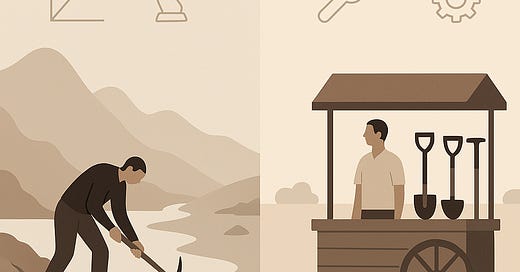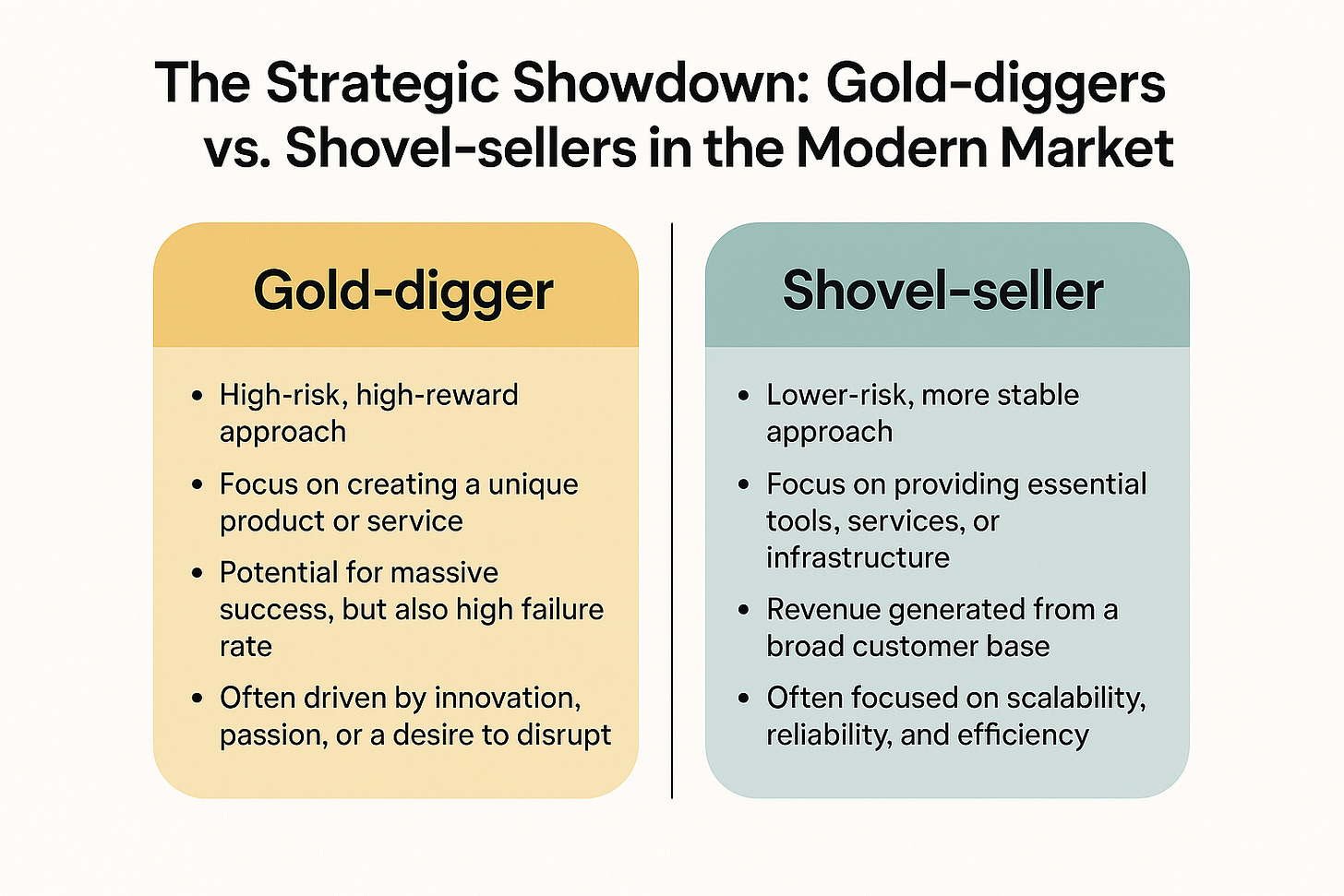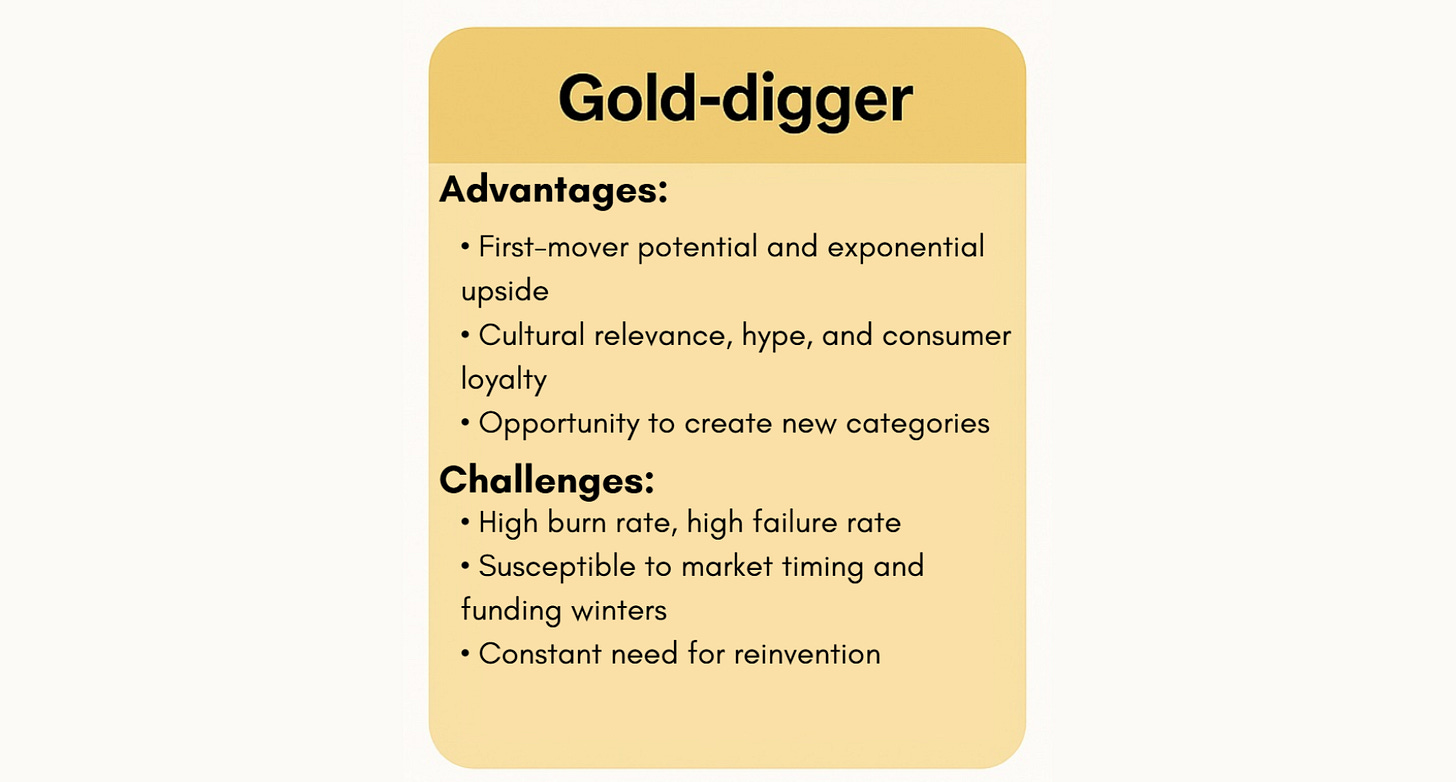The Strategic Showdown: Gold-diggers vs. Shovel-sellers in the Modern Market
The Gold Rush Strategy Series
The Gold Rush Reimagined
In 1849, thousands chased a dream in the dusty hills of California, hoping to strike gold. Some did. Most didn’t. But the ones who consistently profited? The merchants who sold them the picks, shovels, and tents.
That simple truth echoes through time.
Today, the same dynamic plays out in Silicon Valley, on YouTube, in biotech labs, and on Shopify storefronts. While one group pursues the next big breakthrough, another provides the essential tools that make those pursuits possible.
This is The Gold Rush Strategy—a powerful lens through which we can understand business models, career choices, and strategic trade-offs in a volatile, opportunity-rich world. At its core lies a key question:
Are you digging for gold, or are you selling the shovels?
Defining the Players – Mindsets and Models
The Gold-digger – is the bold visionary. Think of the solo founder trying to disrupt fintech, the game studio designing the next viral sensation, or the startup developing a personalized AI tutor. These players chase the prize—market dominance, fame, transformation.
Their approach is fueled by innovation, obsession, and risk.
They thrive in uncertainty. They seek lightning in a bottle.
But for every unicorn, a hundred fade into obscurity.
Hard to recognize them today? They may look like:
A biotech firm racing to commercialize CRISPR-based therapies
An indie developer trying to build the next Among Us
A creator launching a digital course empire on a new platform
The Shovel-seller, by contrast, enables the rush.
They’re the platform, the infrastructure, the enabler.
They don’t care which digger wins—as long as someone’s digging. Their business is volume, reliability, and staying essential.
Rather than betting on one breakthrough, they build systems that support many.
A few examples:
Stripe powering billions in online transactions
Shopify equipping entrepreneurs with digital storefronts
AWS providing cloud muscle to startups and multinationals alike
And then there are the hybrids.
Amazon began as a gold-digger in books. Today, AWS makes it one of the most powerful shovel-sellers in the world.
Canva began as a design tool—now it's an ecosystem where creators, marketers, and teams build and collaborate.
I-shaped vs. Dash-shaped Professionals
This duality plays out in individual careers too.
I-shaped professionals go deep in one domain. They are often gold-diggers—craftsmen, founders, subject-matter obsessives. Their depth can lead to exceptional results, but they’re exposed to industry swings and market shifts.
Dash-shaped professionals are connectors, integrators, enablers. They may not go as deep in one vertical, but they understand how things fit together. They often thrive as shovel-sellers, creating scalable solutions that empower others to shine.
Both are valuable. But they follow different trajectories—and they require different kinds of resilience.
The Strategic Showdown – The Trade-offs in Play
Gold-digger Strategy
Strategic Levers:
Speed, creativity, and product-market fit
Strong storytelling and visionary leadership
Agile experimentation and high adaptability
Shovel-seller Strategy
Strategic Levers:
Infrastructure excellence and uptime
Strong B2B partnerships and ecosystem integration
Brand trust and long-term contracts
Strategic Depth – Playing Both Sides Intelligently
Some of the most resilient and successful companies understand how to move between these modes—or blend them effectively.
Amazon’s story is well-known: after dominating ecommerce (gold-digger), it built AWS (shovel-seller), a bet that quietly underwrites the modern internet.
Adobe empowers millions of creators (shovel-seller) while actively shaping the design landscape with its own AI tools and standards (gold-digger behavior).
Figma began as a digital canvas but became a creative collaboration platform—both enabling and setting trends.
This blend is what I call Strategic Depth—the ability to play multiple roles in the value chain without losing strategic clarity.
To build strategic depth:
Start with core capabilities: What are you truly good at? Is it innovation, infrastructure, experience design, distribution? Your core determines your flexibility.
Balance your resources: Simultaneously supporting a high-risk venture and a high-stability service requires capital, talent, and focus. Know when to specialize—and when to diversify.
Stay situationally aware: You may begin as a gold-digger and evolve into a platform. Or vice versa. The key is adaptability and the willingness to pivot when conditions change.
Be honest about risk: Gold-digging demands resilience and luck. Shovel-selling demands patience and precision. Choose based not on fantasy—but on alignment with your reality.
In conclusion? Know the Game, Then Master the Moves
Both strategies—digging and enabling—are essential to progress. Gold-diggers create new frontiers. Shovel-sellers make those frontiers sustainable.
But the real power lies in clarity.
Are you chasing the next big wave? Or building the surfboard factory?
Are you deep in the mine? Or selling maps and flashlights?
Take a moment to assess your current business, product, or career.
Where do you sit on the spectrum? Gold-digger, shovel-seller—or something in between?
What would it take to deepen your strategy, expand your role, and play with more leverage?
The gold rush isn’t over. It’s just moved online.
And whether you dig or enable—strategy, not luck, will determine who thrives.








